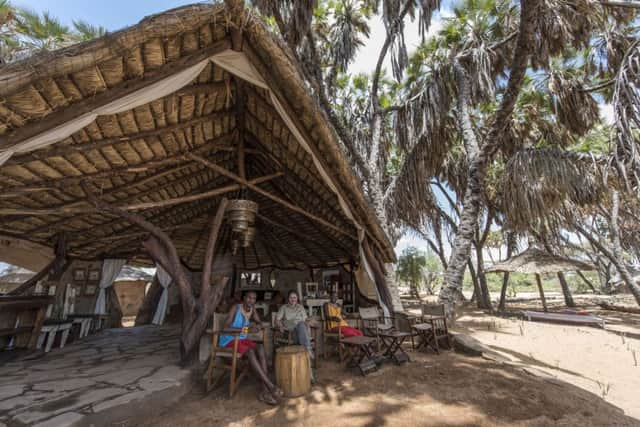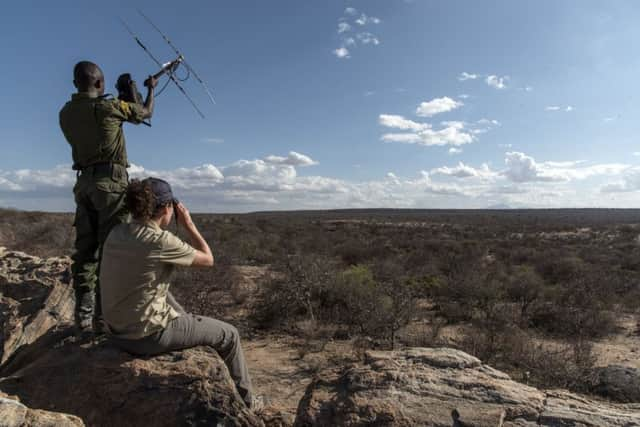Travel review: Kenya offers East Africa's first black rhino tracking experience


Crushing my body tightly against a boulder, I’m frightened to even breathe. Like the final moments in a blockbuster shoot-out, I know at some point I’ll have to move; the question is not if, but when.
Behind this haphazardly stacked kopje sits 50 million years of natural history embodied in almost two thundering tonnes of flesh.
Advertisement
Hide AdAdvertisement
Hide AdI know I’ll soon be rumbled. Yet as I peer over rocks into a crumpled face mapped with more contours than a mountain range, all I want to steal is a glance.


Being within arm’s reach – and trampling distance – of one of the world’s oldest and most critically endangered species is humbling.
And when heavily pregnant Nadungu detects my presence with her acutely-tuned ears, bolting away in a cloud of ochre dust, I’m soberly reminded of how fragile a black rhino’s existence has become.
Between 1960 and 1995, poaching caused a 98 per cent decline of the species and, although the situation has slightly improved, conservationists estimate less than 5,500 survive in the wild.
Advertisement
Hide AdAdvertisement
Hide AdHome to just under 1,000, Kenya is one of the eastern black rhino’s biggest strongholds, and efforts are under way to preserve and grow that population.


What’s more, tourists are now able to observe the animals at a much closer range than ever before, thanks to a pioneering project to return black rhino to a rugged, tribal territory in northern Kenya – uniquely driven by requests from indigenous people living there.
Launched last year, Walking With Rhinos is the first black rhino tracking experience in East Africa.
“When many of our staff were children, poachers would offer them sweets and ask where the rhino were,” recalls Sammy Lemiruni, lodge manager at the Saruni Rhino Camp. “They’d innocently point to a few, hiding in the bushes.”
Advertisement
Hide AdAdvertisement
Hide AdBy the mid-1990s, black rhino had been wiped out completely from this remote sector of Samburu County, which now forms the Sera Conservancy. But in 2015 black rhino from the nearby Lewa Conservancy and other national parks in the country were translocated to a fenced 41 square mile sanctuary within Sera. The birth of Nadungu’s calf a few days ago raises the current number of residents to 12.
Owned by Italian writer and safari guide Riccardo Orizio, the Saruni stable was exclusively invited to set up a lodge within Sera, six miles from the sanctuary. Although foreign owned, the intimate three-banda (stone cottage) enclave is staffed by Samburu swathed in shuka blankets and a rainbow of beadwork.
A few days earlier, I’d arrived in the neighbouring Kalama Conservancy via a 50-minute bush flight from Nairobi, for an overnight stay at Saruni Samburu, a six-villa hilltop camp drowning in views of enormous skies and burning red plateaus.
Driving initially along tarmac road, we soon turned off into the bush for a 30-mile journey to Saruni Rhino, passing only goat-herding pastoralists and camels with bells clanging around their necks.
Advertisement
Hide AdAdvertisement
Hide AdBy the time we reached our final destination, the modern world had disappeared almost completely. Hidden along the banks of a dried-out river bed, Saruni Rhino is remote and wonderfully so.
Sat in an upholstered canoe, I watched an elephant family parade to a watering hole, followed by a Somali ostrich wiggling his pom-pom tail feathers like a cabaret dancer in the Folies Bergère.
Tracking rhino is the obvious focus for guests, but there’s so much more to see.
Rhino within the sanctuary have been fitted with microchips in their horns, allowing rangers to monitor movements. Shy and reclusive browsers, black rhino thrive in the thickets and can be notoriously difficult to find, but using a telemetry device almost guarantees a sighting.
Advertisement
Hide AdAdvertisement
Hide AdA fleeting glimpse of Nadungu has whet my appetite for further encounters, and on our second outing into the sanctuary, we go in search of another female, Napanu.
Standing on top of a rocky mound, rangers Thomas and Anthony take turns in holding aloft an aerial, hoping to detect clicks from chip 16; each rhino is numbered and has its own frequency.
Once Napanu has been located, we travel by foot, led by our guide Sambara who uses a sack filled with ash to gauge wind direction.
Weaving through fairy-tale turrets of termite mounds and spiky commiphora bushes, I painstakingly watch every step, tip-toeing through a minefield of twigs and quartz rocks, trying not to make a noise.
Advertisement
Hide AdAdvertisement
Hide AdWhile closing in on our quarry, we reach a stand-off, frozen for 45 minutes as she grows suspicious of our presence. When she finally moves into the valley, we position ourselves at the base of a hill and marvel as she trots slowly towards us, every fold, crease and skin rumple visible.
This time, there’s no rock to hide behind and with only metres of air between us, her breath almost touches my neck. One camera click results in a mock charge, causing Sambara to intervene by shouting and clapping, leaving me dumbstruck as one of the world’s few surviving black rhinos hurriedly scrambles away.
The return of black rhino to this region of Kenya is more than a conservation effort and revenue generator – it’s also a source of pride for the Samburu people. The same is true for the Reteti Elephant Sanctuary, another pioneering community owned and managed project in neighbouring Namunyak Conservancy.
Arriving early morning after a two-hour drive from Sera, we’re the only tourists privileged to watch a writhing throng of eager trunks reaching for their bottles at feeding time.
Advertisement
Hide AdAdvertisement
Hide AdThere are plans to release some of the 13 elephants into Sera later this year, along with Reteti’s only rhino, three-month-old Loijupu, who was abandoned at birth.
A bundle of wonder and hope, he curiously stumbles towards me and – perhaps naively – I allow him to get much closer than his elders.
But an instinctive foot stamp is a reminder he’s wild, belligerent and, above all, a fighter – like every black rhino today should be.
The Ultimate Travel Company (020 3553 2024, theultimatetravelcompany.co.uk) offers a six-night holiday from £5,237 per person, with three nights at Saruni Samburu and two nights at Saruni Rhino on a fully inclusive basis, including game viewing and rhino tracking at Saruni Rhino. Also includes a night at Ole Sereni Hotel, Nairobi, international flights from London and internal light aircraft flights.
Advertisement
Hide AdAdvertisement
Hide AdBoth KLM (klm.co.uk) and Air France (airfrance.co.uk) offer flights to Nairobi from various regional departure points via their hubs in Amsterdam and Paris. Economy fares from the UK start at £393 return, including taxes and charges.
Loan camera equipment before you travel from Lenses For Hire (lensesforhire.co.uk).